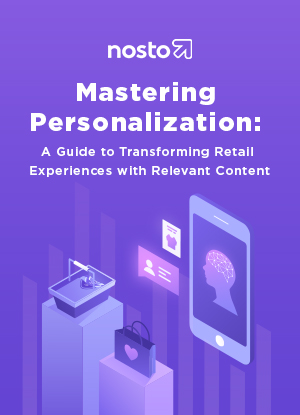The 3 Content Personalization Strategies Retailers Need to Transform Commerce Experiences
In our Mastering Personalization guide, we reveal how retailers can create a successful content personalization strategy that fosters satisfied, longtime customers.
There are several factors that influence a consumer’s decision to purchase a product from a specific brand — with personalized content being one of the most critical ways retailers can capture and maintain customers’ attention in today’s competitive retail market.
Case in point: 66% of consumers will not purchase from a brand whose content is not tailored to their interests, which means retailers lose the potential to convert almost two-thirds of the consumer pool if they aren’t personalizing the content in their shopping experience.
To combat this risk, our industry experts have created an informative guide that explores the three key ingredients of a successful content personalization strategy. By putting these strategies into motion, retailers can increase customer conversion, reduce purchase barriers and deliver hyper-personalized shopping experiences at every stage of the buying journey.
Free guide
Mastering Personalization
A Guide to Transforming Retail Experiences with Relevant Content

As a sneak peek, let’s explore one particular tactic that involves combining customer segmentation with one of the more standard strategies in retail marketing…
The Power of Combining Segmentation with Additional Shopping Context
Every shopper’s experience is unique, and the content you show each of them should reflect that. To fuel these experiences, it’s important to gain a deep understanding of your customers’ traits and behaviors such as:
- Which brands and products are most interesting/relevant to them
- Where they are located (both physically and in the conversion cycle)
- Which channels they use to interact with your brand
With this information, you can then create unique segments that target customers with content that is specific to the segment’s parameters. Some examples of segments retailers create include:
- A segment for new site visitors with an interest in seasonal clothing, who live in a specific city
- A segment for customers who’ve already made a purchase that may require a supporting accessory
- A segment for prospective shoppers who have been led to your online store via a Google or Facebook Ad, but have yet to make a purchase.
Once you’ve determined the segments you want to create, there are a number of ways you factor in additional shopping context to strengthen the value of those segments. One example of what you can do with your segments is using UTM tagging to create unique and engaging landing page content.
Free guide
Mastering Personalization
A Guide to Transforming Retail Experiences with Relevant Content

“Why UTM tags?”, you ask?
With ecommerce conversion rates averaging at or below 3% and paid media CPCs on the rise globally, squeezing the maximum amount out of each visit is paramount for online retailers.
Many retailers are diligent about utilizing UTM tags (e.g. the parameters like “utm_source” found after the question mark in a URL) for tracking both paid and organic campaigns for analysis later in web analytics programs like Google Analytics. What most retailers don’t realize is that that UTM tags are also a powerful tool for creating better and more sophisticated personalization.
Incorporate UTM tags to segment by source channel
Let’s start with the basics. Let’s say you’re a sportswear retailer running two different online advertising campaigns to promote their new line of Adidas jackets—one on Facebook and another through Google Ads. A month after running ads on both platforms, you’ve noticed a massive spike in traffic and sales of Adidas jackets. To take full advantage of this success, you must understand which of the two campaigns drove the higher amount of traffic in order to focus more resources on that channel.
Here’s an example of how your Adidas Jacket campaign could be tagged with UTMs:
- UTM Source (referrer eg. Google, Facebook etc.) = google
- UTM Medium (medium eg. email, cpc, social) = cpc
- UTM Campaign (name of the specific campaign) = discount_adidas_jackets
- The result: https://www.example.com/?utm_source=google&utm_medium=cpc&utm_campaign=discount_adidas_jackets
With this tagging in place, the performance of different campaigns, channels or creative is then tracked using analytics tools such as Google Analytics, providing you with an overview of how each tactic contributes to the overall commercial success of your marketing efforts.

Once you understand where your traffic is coming from, you can personalize your store’s homepage to reflect content that your shoppers are most interested in seeing based on where they came from. This can be done by creating a segment of users that visit your site via a specific UTM campaign.
Free ebook
Mastering Personalization
A personalized shopping experience achieves higher order value and higher conversion rate

In this guide, you will also learn:
- How to create a successful content personalization strategy across the customer lifecycle
- Best practices for optimizing content based on customer behavior
- Detailed examples of retailers deploying successful content personalization strategies in the real world.




